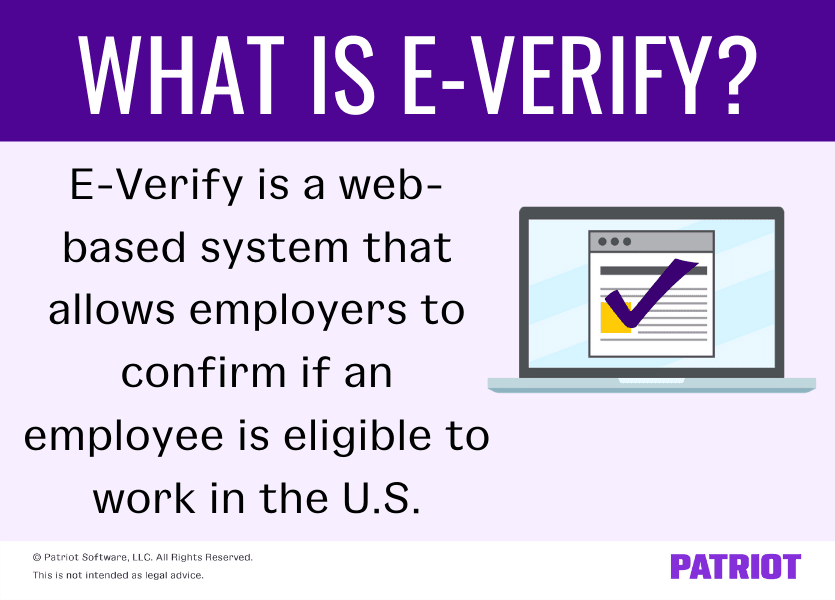As an employer, you’re responsible for collecting certain forms from new hires, like Form I-9. Form I-9 is a form that confirms your employees are legally allowed to work in the U.S. To help confirm the eligibility of your new employees, you can use E-Verify. So, what is E-Verify exactly?
A quick overview of Form I-9
Again, use Form I-9, Employment Eligibility Verification, to verify that your employees are legally able to work in the United States.
You and your employee both have to fill out sections of Form I-9. And, your employee must provide specific documentation and identification (e.g., driver’s license, Social Security card, etc.) for you to review.
Employers must review and verify the form and the employee’s I-9 documents within three days of the employee’s first day of work.
After you review the form, keep Form I-9 in your payroll records. Store Form I-9 for at least three years after you hire an employee or one year after their employment ends (whichever is later).
What is E-Verify?
Now onto the part you’ve been waiting for: What is E-Verify? E-Verify is a web-based system that allows employers to confirm if an employee is eligible to work in the U.S. Basically, an employer can use E-Verify to double-check an employee’s employment eligibility. You cannot use E-Verify to reverify expired employment authorization (Section 3 on Form I-9) for an alien authorized to work in the U.S.
E-Verify is a secure Department of Homeland Security (DHS) website for employers to use to cross-check I-9 information. Currently, there are over 967,000 employers enrolled in E-Verify.
The E-Verify system has a lot of perks. E-Verify is:
- Free
- Easy-to-use
- All online
- Fast
- Accurate
Using E-Verify can also give you peace of mind knowing your worker is eligible to work in the U.S.

How does an E-Verify check work?
You might be wondering, How does E-Verify work? and What does E-Verify check? Both great questions.
The E-Verify system compares information from an employee’s Form I-9 to the U.S. Department of Homeland Security’s and Social Security Administration’s records to confirm employment eligibility. The system looks at millions of government records to ensure that results are accurate for employers.
The verification system is 100% online, and can provide results to employers within a matter of seconds.
In the verification process, an employer creates a “case” by entering information from an employee’s Form I-9. The system then takes the information and compares it to available government records. Typically, the employer receives a response within a few seconds indicating the employee’s employment eligibility. In some cases, an employer may need to provide additional information or take additional actions to complete the case.
Is Form I-9 E-Verify mandatory?
No, E-Verify is voluntary for most employers. However, there are a couple of exceptions. Employers may be required to participate in E-Verify if:
- They have federal contracts or subcontracts that contain the Federal Acquisition Regulation (FAR) E-Verify clause
- Their state has legislation mandating the use of E-Verify
- They have to follow a legal ruling
Alabama, Arizona, Georgia, Mississippi, North Carolina, South Carolina, Tennessee, and Utah require most employers to use E-Verify. And, other states have E-Verify requirements for certain businesses, such as public employers. Check with your state for more information on E-Verify requirements.
How do you set up an E-Verify account?
Again, the E-Verify program is all online. There is no cost to enroll your business. However, you do have to sign a Memorandum of Understanding (MOU), a legally binding contract between you and the DHS. To enroll in E-Verify, you need to gather some information, including:
- Contact information (e.g., name, phone number, email)
- Company name
- DBA name (optional)
- DUNS number (optional)
- Physical address of the location where your company will access E-Verify
- Company mailing address (if different from physical address)
- Federal Employer Identification Number, or FEIN
- Estimated number of employees
- First three digits of your business’s NAICS code
- The number of hiring sites that will participate in E-Verify in each state
To start enrolling your business and verifying employees, go to the E-Verify website and click “Enroll Now.” The program will walk you through the enrollment process and require you to enter the above information.
Check the E-Verify website for more enrollment guidelines and checklists.
How do you use an E-Verify account?
After you enroll your business, you can begin creating cases in your account (aka entering information from Form I-9 to verify employment eligibility).
To create a case, log into your account and click “New Case” in the dropdown list under “Cases.” From there, you must enter information from your employee’s Form I-9 and follow the steps.
With E-Verify, you must have the employee’s Social Security number and an employee photo from List B on Form I-9 (e.g., driver’s license photo).
You must create a new E-Verify case no later than the third business day after the employee starts work.
Once you go through the steps to add a new case and submit it, you should get your results within a few seconds. In some cases, the program may ask you to confirm a few additional details (e.g., spelling of employee’s name). If that happens, cross-check the information they’re asking for with what is on the employee’s form.
For more information about verifying employee I-9 information in your account, review the E-Verify website’s case instructions.
Need an affordable and easy way to pay your employees after you verify their employment eligibility? With Patriot’s online payroll software, you can run payroll in three simple steps. And, we have free USA-based support. What are you waiting for? Try it for free today!
This article has been updated from its original publication date of August 30, 2011.
This is not intended as legal advice; for more information, please click here.



